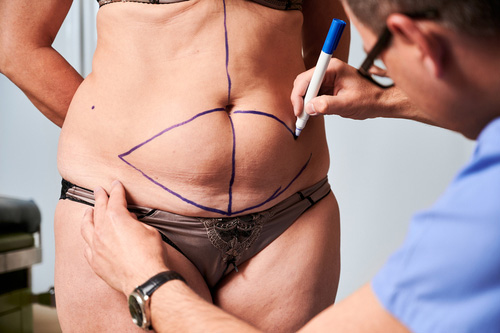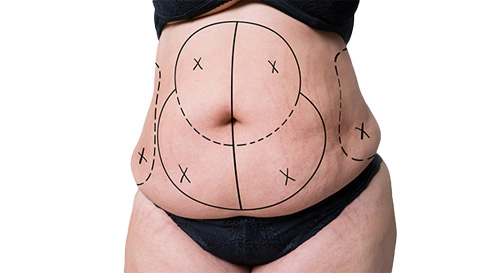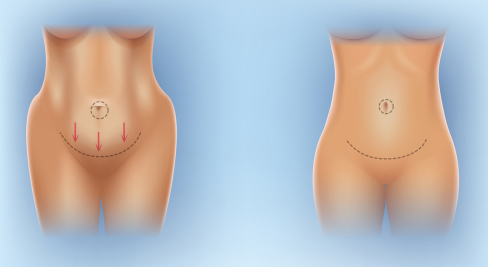Tummy Tuck Abdominoplasty Cost, Details and Recovery in Turkey

- What is Tummy Tuck Abdominoplasty?
- Tummy Tuck Abdominoplasty Prices
- Abdominoplasty Procedure
- Tummy Tuck Abodminoplasty Methods
- After the Tummy Tuck Abdominoplasty
- Risks of Tummy Tuck Abdominoplasty
- When is the right time for having abdominoplasty?
What is Tummy Tuck Abdominoplasty?
A tummy tuck (also called abdominoplasty) in Turkey is used to remove excess skin in the abdominal area. Wrinkled, hanging flaps of skin (fatty flaps) are often the result of extreme weight loss, for example weight loss after pregnancy, diets or stomach reductions. A congenital weakness of the connective tissue or increasing age can also contribute to the development of a severely expanded abdominal wall.In addition to hanging flaps of skin, those affected often also suffer from:
- Stretch marks (pregnancy marks)
- A drifting apart of the vertical abdominal muscles (rectus diastasis)
Depending on the physical condition and wishes of the patient, the attending doctor can decide on different surgical methods for the abdominal wall lift. During the operation, a horizontal incision is made over the intimate area. After surgery, this scar will fade, as will a scar that surgeons leave on the belly button. A tummy tuck is not intended to reduce weight and should only be attempted once your personal ideal weight has been reached.
Abdominoplasty in Men
In men, too, sagging skin areas lead to problems after significant weight loss or as a result of increasing age. The partial abdominoplasty, also known as mini tummy tuck, is predominantly used here, but the major abdominoplasty, i.e. the large abdominal wall lift, in which the navel is also moved, is predominantly used.
Tummy Tuck Abdominoplasty Prices
Tummy tucks are considered medically unnecessary procedures. This means that the costs are usually not covered by health insurance companies. However, the massive flaps of skin can lead to further health impairments - and their removal can represent a medical indication, so that the costs may be covered by health insurance companies.For example, when significant discomfort is caused by an apron of abdominal fat or when stubborn eczema (inflammatory skin diseases) develops under the overlapping skin folds. Wet inflammation under the abdominal fat apron can lead to colonization with fungi, which can also pose a medical consequential problem that favors the assumption of costs by health insurance companies. Because the only therapeutic approach that promises healing here lies in the removal of the excess skin parts.
A written statement by the health insurance company that will cover the costs is important for the treatment, because without this many hospitals will not accept the patients. Patients must apply to their health insurance company themselves to have the costs covered, in coordination with their doctor. The application should be submitted to the health insurance company in writing and by post, signed by the insured person, as a registered letter with a return receipt. If the health insurance company rejects the application, it is possible to object. If the objection is unsuccessful, the patient can file a complaint with the social court.
The prices for a tummy tuck in Europe vary greatly and can range from 3,500 to 10,000 euros - depending on the extent of the areas to be treated, the amount of tissue to be removed and also depending on the practitioner and clinic.
Abdominoplasty Procedure
A tummy tuck is a major surgical procedure and is usually performed by aesthetic plastic surgeons under general anesthesia in a clinic. If necessary, the doctor will move the belly button. Before the actual procedure, you will discuss in detail with the surgeon what you want and can achieve with the operation. A tummy tuck is not suitable for everyone.There is enough time between the preliminary talk and the procedure so that you can think twice about the operation. You will also find out whether you need to stop taking certain medications, such as blood thinners or antihypertensive drugs. To minimize the risk of surgery, your doctor will advise you to begin light walking or cycling, designed to improve your general fitness, two to three months before the procedure.
Directly before the operation, your doctor will mark the regions where he will remove fat and perform a tightening.

Tummy Tuck Abodminoplasty Methods
Abdominoplasty is the most common surgery performed after weight loss surgeries. An important prerequisite is that the patient has now reached a body weight with which patient is satisfied. There are essentially five different methods used for a tummy tuck. Which technique the surgeon chooses depends on the patient's physical requirements and individual ideas.There are these surgical techniques:
- Mini tummy tuck
- Major tummy tuck - fleur de lis technique
- Upper tummy tuck
- Fat Apron Removal
- Body lift
Mini Tummy Tuck - Partial Abdominoplasty
In a small tummy tuck - also called partial abdominoplasty, mini abdominoplasty or mini tummy tuck - only the skin between the navel and the abdominal incision is detached and tightened. This also includes the pubic area and groins. The navel can remain in its original position, but it still moves down due to the tightening.This method of tummy tuck is rarely used for patients who have lost a lot of body weight, but is more suitable for slim patients who are dissatisfied with their lower abdomen. The procedure is not as complex as a full tummy tuck and is also less risky and uncomplicated.

A general anesthetic is not always necessary for this procedure, the patient is only put into a light twilight sleep. As with the complete tummy tuck, the incision is made between the pelvic bones above the pubic line for the mini tummy tuck. The skin is loosened from the underlying muscles up to the level of the navel and then pulled tight. The excess skin is removed, then the incision is sewn up. In the case of a mini tummy tuck, the duration of the operation is only about one to two hours and patients are unable to work for about two weeks after the procedure.
Major Tummy Tuck - Total Abdominoplasty
In a major tummy tuck - also known as a total abdominoplasty - the entire abdominal area is tightened up to the costal arch. It is by far the most commonly used method for tightening excess tissue. Doctors always perform major tummy tuck under general anesthesia. Excess skin and subcutaneous fatty tissue are removed and the abdominal wall is tightened. With this method, doctors also move the navel. The duration of the operation can be between two and four hours. You will stay in the hospital for between four and seven days for this, and you will wear the bandages for up to eight weeks.For a major tummy tuck, an arcuate incision is made. The navel is also cut out in a circle and reinserted. Excess skin and abdominal fat are removed. The abdominal wall is pulled down. Wound drains are embedded for healing, after which the abdominal wall is sewn up again. Scars longer than 50 cm may remain, but with appropriate care they will heal well.

This procedure can also be used to remove navel hernias, or inguinal hernias. Scars, such as those caused by a caesarean section, can also be corrected with total abdominoplasty. Years of obesity or pregnancy can cause the vertical abdominal muscles to drift apart. Doctors speak of a so-called rectus diastasis. This can be corrected with total abdominoplasty. The muscles are tightened so that a so-called "inner corset" is created. The result is a narrower waist and a significantly strengthened abdominal wall. This part of the operation may be covered by your health insurance company.
In many cases, a tummy tuck is combined with liposuction. In addition, if necessary, fat in the hip and waist area can be suctioned out to further improve the result. After the operation, a special bandage will be applied to you, after which you will wear a compression garment for up to six weeks to support your stomach.
FLEUR DE LIS Technique
In the case of excess skin and fat above the navel, the horizontal incision from iliac crest can be extended by a vertical incision from the pubic area towards the navel, which would result in an inverted “T” on the drawing. This creates more scarring than with classic abdominoplasty. Since the course of the scar corresponds to a stylized lily, the name "Fleur de Lis" came about.The disadvantages are scars that are difficult to conceal and run across the entire abdomen. The stay in the clinic after the operation is between four and seven days, and patients have to wear the bandages for up to eight weeks.
Upper Tummy Tuck Abdominoplasty
In many cases, overstretched skin also affects the breast. An incision in the lower breast crease is necessary for an upper tummy tuck, which is why it is mostly used in combination with a breast lift or reduction, where this incision technique is carried out anyway.
If there is excess skin on the lower abdomen, a simultaneous mini tummy tuck can be useful. However, this technique is only rarely used because unsightly scars often form in the lower breast folds. This method is also known as a T-cut because the incision is placed below both underbust creases. This operation can also take up to three hours and requires a hospital stay of between three and seven days.
Fat Apron Removal
In the case of fat apron removal, or dermolipectomy, as it is called by doctors, only excess skin and fat tissue is removed. The anterior trunk wall is not tightened. These interventions are performed less frequently. Patients who decide to have a fat apron removed are usually still overweight. Fat aprons can be extremely stressful for those affected, as inflammation quickly develops under them and the weight means massive restrictions in everyday life.The risk of complications occurring after the operation is relatively high due to the remaining fatty tissue masses. The operation is always performed under general anesthesia. The incision is made along the fold of the fat apron. Patients stay in the hospital for up to ten days. After the operation, an abdominal belt is put on; this must be worn for up to three months.
Typical risks are wound infections of the suture and the death of fatty tissue, so-called fatty tissue necrosis. The risks of the operation must always be discussed and weighed up with the patient, because many of those affected regain a large part of their quality of life, they can move more freely and easily after the operation.

Abdominoplasty with Liposuction
In the case of a tummy tuck, unsightly darts can occur at the transition from the wound suture to the surrounding tissue, so-called “dog ears”. These can be very well corrected by liposuction. Liposuction creates finer contours and smooth transitions, the excess is simply sucked off and a better result is achieved.
Abdominoplasty without surgery
There is no such thing as a tummy tuck without surgery. Abdominoplasty is always a surgical procedure.
Body Lift
Body lifting is particularly suitable for patients who have lost a lot of weight. Not only the abdomen and waist, but also the buttocks, outer thighs and hips are included in the tightening. The operation is therefore made up of several sub-operations. The operation is performed under general anesthesia.Since several areas of the body are tightened during a body lift, surgeons make several incisions, resulting in several longer scars. First, an incision is made in the lower back area. This is guided forward along the hip below the pelvic bones. The abdominal procedure is the same as for a total abdominoplasty. In addition, an incision on the inside of the thighs may be necessary to tighten them as well. Excess skin and fat are removed and the skin is then sewn up.
The operation can be divided into two parts, so that the healing phase is more bearable for the patient. This is always the better choice when extremely large amounts of excess skin have to be removed. The first operation often involves tightening the abdomen and buttocks. The thighs are then treated in a second procedure.

After the Tummy Tuck Abdominoplasty
After a tummy tuck, patients have to take it easy for up to eight weeks and put as little stress on the surgical sutures as possible. Depending on the severity and extent of the tightening performed, the healing time can range from several weeks to a few months.After the operation, you should sit up slowly with the help of a nurse and only get up under supervision. It is important not to tense the abdominal muscles – neither when going to the toilet nor when coughing. The intestines also have to get used to the tighter space – so you should ensure soft bowel movements.
In the days after the operation, do not force yourself to walk upright, but straighten up so that you do not feel any tension on the scar. You'll notice it when you can sit up a little further.
Pain is rather rare, most patients find the procedure to be relatively painless. Nevertheless, well-tolerated painkillers, tailored to the needs of the patient, are prescribed. In addition, a stomach protector should be taken once a day. For the period of their inpatient stay, the patients also receive a daily injection for thrombosis prophylaxis. Antibiotics are also prescribed for about one to five days.
After the operation, a plaster bandage protects the wounds, and compresses also fix the area. Custom-made compression underwear is put on in the operating theatre. It prevents cavities created by the operation from filling with tissue fluid, blood or dissolved fat.

The compression garment should be worn continuously for six to eight weeks. The bodice is very important because it counteracts swelling, stabilizes the fresh seams, protects against overloading and relieves the wound. The bodice can be removed for a short shower, but the wounds must be protected with special shower plasters. If the wounds or the staple plasters still get damp, they must be gently blow-dried if necessary. Otherwise, the bodice should be worn day and night, even when sleeping.
The first plasters should be changed after two to three days. The plasters that are then stuck on can remain on the wounds for five to ten days. In the case of leaking wounds, a doctor should change the band-aids.
Approximately two to three weeks after the operation, all scabs will have fallen off, then the scars can be treated with silicone gel pads. This is considered the best measure to for healing after the tummy tuck.
If a pregnancy is planned, tummy tuck shouldnt be performed.
Risks of Tummy Tuck Abdominoplasty
Tummy tucks are now widely performed and it is a routine procedure. Nevertheless, you should take the time to look for an experienced expert who has already carried out this procedure many times.In order to prevent the risk of impaired wound healing and to avoid complications, you should stop smoking for at least two weeks before a planned tummy tuck until the healing process is complete. In addition to smokers, diabetics and people with blood clotting disorders are also at risk of delayed wound healing.
Risks of a tummy tuck are:
- Infections (by inserting drains under the abdominal wall, however, doctors can greatly reduce the risk of infection)
- Scars that tear open and bleed
- Wound healing disorders
- Swelling
- Bruises
- Severing of nerves with subsequent loss of feeling
- Scars can widen after the operation due to overstretched skin.
- Problems related to belly button
- An unsightly asymmetry can arise that needs to be treated afterwards.
- Thrombosis or pulmonary embolism are among the other possible risks of the procedure under general anesthesia.
- A loss of feeling in the tightened area is also relatively common, as nerves have been severed here. It can take up to two years for the sensation to fully recover.
- Locally limited wound healing disorders are the most common of all the complications mentioned. Therefore, it is imperative to keep wounds clean and dry, not to smoke, and to avoid tension on the wounds.

Those who have been operated on are unable to work for between four and eight weeks. You should avoid sport for up to six weeks. After that you can start doing light endurance exercises again, from the sixth week you can slowly jog or swim. It is also very important that you do not lift any heavy objects. Up to twelve weeks after the operation, you should not lift any heavy objects weighing more than 15 kilograms.
When is the right time for having abdominoplasty?
Tummy tucks are surgical procedures. Excess fat and skin tissue is removed and the front muscles in the abdomen are tightened. Tummy tucks are often performed after pregnancies with significant weight gain and loss or generally after significant weight loss. Only when you have reached your personal ideal weight should you think about tightening, because the procedure is not suitable for weight reduction.There are no comments yet. Would you like to add a comment?
In accordance with Article 10 of the Personal Data Protection Law (PDPL,KVKK) titled Data Controller's Obligation to Disclose, we use cookies in accordance with the legislation, limited to the purposes specified in the privacy policy.

